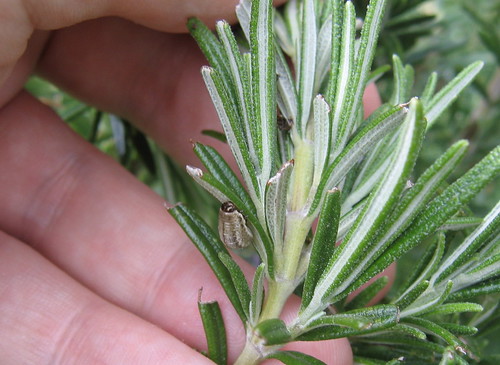I was pruning back a rosemary bush to get rid of what I vaguely thought were frost damaged leaves left over from winter, so I’d have some less manky rosemary to cook with, and found these:
Which I immediately recognised from a photo in the London Wildlife Trust newsletter, though I couldn’t remember what they were called. It turns out they’re Chrysolina americana, the Rosemary Leaf Beetle.
Pretty, aren’t they? Something I’d be much more enthusiastic about if the little bastards weren’t eating the rosemary that I want to eat. Apparently they’re native to southern Europe and can’t fly, but have become an established pest in England, especially London, over the past ten years. No doubt they got here on rosemary and lavender plants (which they also eat) and I guess they must crawl from plant to plant, guided perhaps by their sense of smell. The suggestion is that they’ve only become established over the past decade because global warming has brought milder winters, so they’re a harbinger of doom as well as a pest. Here’s one of the grubs, and a rare shot of part of my hand:
You can also see some of the damage, though it was a lot worse than that on other parts of the plant.
More evidence of spring, apart from the randy beetles: I’m up to four butterfly species for the year (Small White, Brimstone, Peacock and Comma). On the bird front, I saw my first summer visitors of the year last week; Chiffchaffs singing in the woods. Although according to that page, a few hundred of them now overwinter each year in southern England—probably another sign of global warming—so perhaps the ones I saw haven’t come from Africa after all.
There are ducklings and cootlings in the park, and a pair of Little Grebes—a contender for the cutest bird in Europe— haphazardly dragging around bits of weed as though they were about to build a nest. Which is exciting because it’s the first time I’ve seen them there. My sense is that they are becoming more common in London; certainly in my copy of the Atlas of Breeding Birds of the London Area from 1977, the Little Grebe map doesn’t have many orange blobs on it. That, at least, probably isn’t anything to do with climate change. More likely the grebes are adapting to city life.

